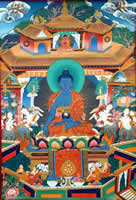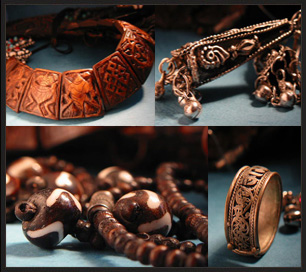Light Blue (Turquoise) in Buddhism
The significance of the light shade of blue is reflected in the importance of the semi-precious stone turquoise in the daily spiritual and religious life of the devout Buddhist, who holds various beliefs about this stone. In general terms turquoise is a symbol of the blue of the sea and the sky. Infinity in the sky speaks of the limitless heights of ascension. The stone is opaque as the earth, yet it lifts the spirit high, laying bare to us the wisdom of both the earth and the sky.
When worn in a ring, turquoise is believed to assure a safe journey; worn in the ear it prevents reincarnation as a donkey; appearing in a dream, it is auspicious; when found, it brings the best of luck and gives new life (in contrast, it is not considered lucky to find gold or coral); when changing its color to green, it indicates hepatitis, yet at the same time it draws out jaundice. Most importantly it is believed to absorb sin.
Strings of prayer beads too include turquoise. In fact, when worshipping the popular goddess Tara in her green form, because of the color association, it is desirable to do so with a rosary entirely composed of turquoise beads.
There also exists as well the concept of living and dead turquoise. Living turquoise has a healthy blue color, whereas dead turquoise has turned either white or black. In the natural aging process of turquoise, exposure to light and body oils darkens the color, eventually turning it black. Tibetans compare this to human aging and death. Wearing "living" turquoise is therefore very desirable, as it will give long life to the wearer.
Turquoise has also been held as a sacred stone by ancient cultures other than Tibetan. It was sacred in Egypt, along with malachite and lapis lazuli. It was also sacred to the Persian culture, where it symbolized purity. American Indians believe it to be a protector and guardian of the body and soul. Gypsies wear turquoise in their navels, believing it to be good for everything.
Dark Blue (Lapis Lazuli) in Buddhism
Nothing illustrates more the spectacular influence of the darker blue on Buddhist aesthetics than the 'Blue Buddha', also known as the Buddha of Medicine or Healing. The most distinctive feature of this Medicine Buddha is his color, the deep blue of lapis lazuli.
 This precious stone has been greatly prized by Asian and European cultures for more than six thousand years and, until relatively recently, its ornamental value was on a par with, or even exceeded, that of the diamond. An aura of mystery surrounds this gemstone, perhaps because of its principal mines are located in the remote Badakshan region of northeast Afghanistan, an all-but-inaccessible area located behind the Hindu Kush. One commentator has written, "the finest specimens of lapis, intensely blue with speckled waves and swirls of shining gold-colored pyrite, resemble the night aglow with myriads of stars."
This precious stone has been greatly prized by Asian and European cultures for more than six thousand years and, until relatively recently, its ornamental value was on a par with, or even exceeded, that of the diamond. An aura of mystery surrounds this gemstone, perhaps because of its principal mines are located in the remote Badakshan region of northeast Afghanistan, an all-but-inaccessible area located behind the Hindu Kush. One commentator has written, "the finest specimens of lapis, intensely blue with speckled waves and swirls of shining gold-colored pyrite, resemble the night aglow with myriads of stars."
E.H. Schafer summarizes the Buddhist interest in lapis lazuli:
The Chinese were not alone among the Far Eastern peoples in their admiration for the blue mineral. The Tibetans valued it above all others, even ahead of gold, and those highlanders saw in it the image of the azure sky, and said that the hair of their goddess had its color. Both men and women wore it on their heads.
Indeed to this day, statues prepared in Tibet and the Himalayn kingdom of Nepal have their hair painted blue.
Traditionally this beautiful stone was used to symbolize that which is pure or rare. It is said to have a curative or strengthening effect on those who wear it, and its natural smoothness allows it to be polished to a high degree of reflectivity. Specifically in alternative medicine, because of it being associated with a certain 'coolness', it is used when inflammation is present, or when any internal bleeding or nervous condition exists. For all these reasons, plus the fact that deep blue light has a demonstrable healing effect on those who use it in visualization practices, lapis is the color of the principal Medicine Buddha, making this stone an important one in Buddhist mysticism.
Indeed the Lapis Healing Master is one of the most honored figures in the Buddhist pantheon. In one of the main sutras (canonical texts) concerning the Medicine Buddha, Shakyamuni tells his close disciple and attendant Ananda:
I beseech you, Blessed Medicine Guru,
Whose sky-colored, holy body of lapis lazuli
Signifies omniscient wisdom and compassion
As vast as limitless space,
Please grant me your blessings.




添加新评论